A 2013 Hyundai Sonata Brake Caliper Diagram
Hyundai Sonata Front Brake Pads Replacement Guide
How to replace the front brake pads on a 2011, 2012, 2013 & 2014 Hyundai Sonata with picture illustrated instructions.
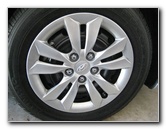
Sonata Front Wheel
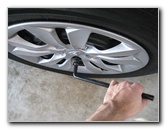
Loosen 5 Lug Nuts

Floor Jack - Raise Vehicle
Owners of other Hyundai or Kia vehicles such as the Elantra, Accent, Veloster, Tucson, Santa Fe, Veracruz, Genesis, Forte, Optima, Rio, Soul, Sedona, Sorento and Sportage may also find these DIY instructions to be helpful.
The tools needed to complete this front brake job include the following: a floor jack, jack stands, a lug nut wrench, a 14mm socket with ratcheting wrench and a "C" or "F" clamp.
A few of the aftermarket brake pads compatible with the Sonata include the following with their respective part numbers: Hyundai 58101-3QA10, Wagner ZD1444, Bosch BC1444, Akebono ACT1444, ACDelco 17D1444CH, Raybestos PGD1444C, KFE KFE1444-104, Wagner QC1444 and TRW TPC1444.
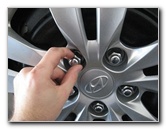
Spin Off Lug Nuts
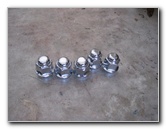
Lug Nuts Removed
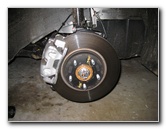
Brake Caliper & Rotor
Then slightly loosen the five lug nuts on the front wheel with the tire iron before raising the vehicle with the floor jack and securely supporting it with the jack stands.
Spin off the five lug nuts the rest of the way and put them aside in a safe place. Pull off the wheel to expose the front brake caliper, bracket, and rotor.
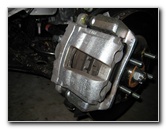
Front Brake Caliper
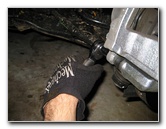
Remove Lower Caliper Bolt
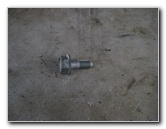
Lower Caliper Bolt
Remove them with the 14mm socket and ratcheting wrench by turning them clockwise (as seen from the outside of the vehicle).

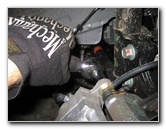
Remove Upper Caliper Bolt
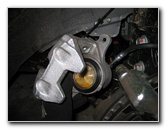
Pull Off Brake Caliper
Carefully rest the brake caliper on the suspension arm without placing any stress on the rubber brake lines.
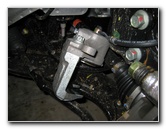
Rest Caliper On Suspension
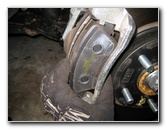
Pull Out Old Brake Pads
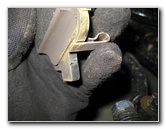
Wear Bar - Bottom Inner
On this 2011 Sonata, the wear bar was situated at the bottom of the inner brake pad.
I recommend buying the Wagner QuickStop ZD1444 brake pads since they have excellent reviews on Amazon.

Replace Anti-Rattle Clips

Brake Parts Cleaner Spray
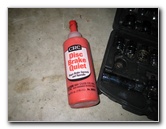
CRC Disc Brake Quiet Gel
Clean off the rotor, caliper body, caliper piston and caliper bracket with some brake parts cleaner spray.
To help prevent braking noise, apply some CRC Disc Brake Quiet gel or a similar product to the rear of the brake pads where they come in contact with the caliper. (Do not apply anything to the friction surface of the new pads.)
![]() If your vehicle exhibits shuddering, pulsating, or vibrations during braking, you may need to have your rotors "turned" (resurfaced) or just replace them with brand new rotors. If this is the car's first front brake job and the rotors appear to be in excellent condition, you should be able to just replace the pads with great results.
If your vehicle exhibits shuddering, pulsating, or vibrations during braking, you may need to have your rotors "turned" (resurfaced) or just replace them with brand new rotors. If this is the car's first front brake job and the rotors appear to be in excellent condition, you should be able to just replace the pads with great results. ![]()
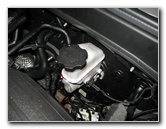
Brake Fluid Reservoir
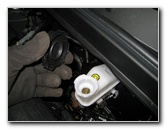
Remove Reservoir Cap
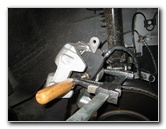
Compress Caliper Piston
But first, remove the cap on the brake fluid reservoir in the engine bay by turning it counter-clockwise.
Removing the reservoir cap will allow the brake fluid to more easily travel backwards through the lines when the piston is compressed.
Attach the "C" or "F" clamp to the caliper using the back of an old brake pad to help evenly distribute the force across the piston.
Very slowly compress the brake caliper piston until it rests flush with the rubber dust boot. Check the brake fluid level in the reservoir repeatedly while compressing the piston to ensure that it does not overflow.
Brake fluid is harmful to any painted surface.
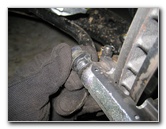
Remove Caliper Pin
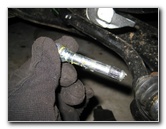
Inspect Slider Pin
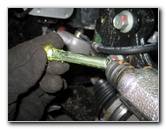
Lubricate & Replace Pin
If the caliper pins seem dry, lubricate them generously with some high pressure / temperature brake caliper grease.
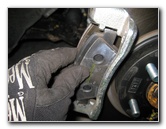
Install New Brake Pads
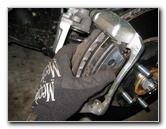
Push Pads Flush On Rotor

Lower Caliper Over Pads
Push the two new brake pads together until they are flush against the rotor.
Carefully lower the brake caliper over the new brake pads and line up the bolt holes with the slider pins.
If the caliper won't fit over the new brake pads, you may need to compress the piston back a bit more.
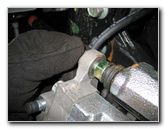
Insert Caliper Bolts
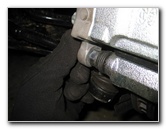
Insert Lower Caliper Bolt
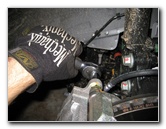
Tighten Caliper Bolts
Tighten the two 14mm caliper bolts to just past hand tight or about 20-25 ft lbs of torque.
Double check that both caliper bolts are snug before continuing on to the final steps.
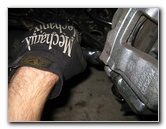
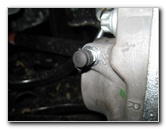
Bleeder Valve Cover
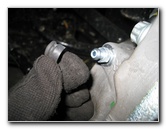
Brake Line Fluid Bleeder
It would be best to bleed the brake lines at this time in order to flush out the old fluid and replace it with new DOT 3 brake fluid. For more on this topic, check out my Brake Line Fluid Bleeding DIY Guide.
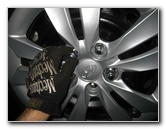
Replace Wheel & Lug Nuts
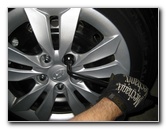
Tighten 5 Lug Nuts
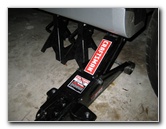
Lower Vehicle
Lower the vehicle from the jack stands and floor jack until the front tire holds some of the vehicle's weight.
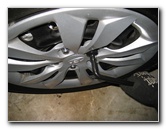
Torque To 100 ft lbs

Check Reservoir Fluid Level
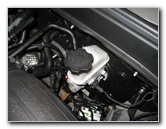
Replace Brake Fluid Cap
It would be best to use a torque wrench or an air gun with torque stick to tighten the lug nuts to about 75-100 ft lbs.
Sit in the driver's seat of the vehicle and press the brake pedal a few times to restore the brake line pressure.
Then check the brake fluid level in the reservoir and verify that it is at the "MAX" (maximum) line.
Once the brake fluid level is correct, replace the brake fluid reservoir cap by twisting it on clockwise.
To break in your new front brake pads, just drive normally for the first few hundred miles while trying to avoid any hard or "panic" stops which may glaze over the new brake pads and cause them to be noisy and/or not perform well.
It's also a good idea to regularly examine your driveway for drops of brake fluid which may indicate a leak, check the brake fluid level in the reservoir, and also check that the lug nuts are still properly tightened.
For more, check out my Hyundai Sonata Repair & Maintenance Guides page.
Posted by: dallasrousellssa.blogspot.com
Source: https://paulstravelpictures.com/Hyundai-Sonata-Front-Brake-Pads-Replacement-Guide/
Komentar
Posting Komentar